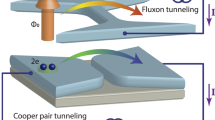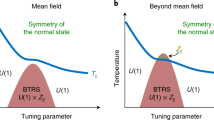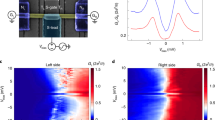Abstract
Quantum phase transitions (QPT) between distinct ground states of matter are widespread phenomena1,2,3,4,5, yet there are only a few experimentally accessible systems6,7 where the microscopic mechanism of the transition can be tested and understood. These cases are unique and form the experimentally established foundation for our understanding of quantum critical phenomena. Here we report that a magnetic-field-driven QPT in superconducting nanowires—a prototypical one-dimensional system (d=1)—can be fully explained by the critical theory8,9 of pair-breaking transitions characterized by a correlation length exponent v≈1 and dynamic critical exponent z≈2. We find that in the quantum critical regime, the electrical conductivity is in agreement with a theoretically predicted scaling function and, moreover, that the theory quantitatively describes the dependence of conductivity on the critical temperature, field magnitude and orientation, nanowire cross-sectional area, and microscopic parameters of the nanowire material. At the critical field, the conductivity follows a T(d–2)/z dependence predicted by phenomenological scaling theories10,11 and more recently obtained within a holographic framework12. Our work uncovers the microscopic processes governing the transition: the pair-breaking effect of the magnetic field on interacting Cooper pairs overdamped by their coupling to electronic degrees of freedom. It also reveals the universal character of continuous quantum phase transitions.
This is a preview of subscription content, access via your institution
Access options
Access Nature and 54 other Nature Portfolio journals
Get Nature+, our best-value online-access subscription
$29.99 / 30 days
cancel any time
Subscribe to this journal
Receive 12 print issues and online access
$209.00 per year
only $17.42 per issue
Buy this article
- Purchase on Springer Link
- Instant access to full article PDF
Prices may be subject to local taxes which are calculated during checkout




Similar content being viewed by others
Change history
18 July 2018
In the version of this Letter originally published, one of the authors’ first names was incorrectly spelled Fédéric; it should have read Frédéric. This has now been corrected.
References
Steppke, A. et al. Ferromagnetic quantum critical point in the heavy-fermion metal YbNi4(P1−xAsx)2. Science 339, 933–936 (2013).
Marković, N., Christiansen, C. & Goldman, A. M. Thickness–magnetic field phase diagram at the superconductor–insulator transition in 2d. Phys. Rev. Lett. 81, 5217–5220 (1998).
Zhang, X., Hung, C.-L., Tung, S.-K. & Chin, C. Observation of quantum criticality with ultracold atoms in optical lattices. Science 335, 1070–1072 (2012).
Cejnar, P., Jolie, J. & Casten, R. F. Quantum phase transitions in the shape of atomic nuclei. Rev. Mod. Phys. 82, 2155–2212 (2010).
Alford, M. G., Schmitt, A., Rajagopal, K. & Schäfer, T. Color superconductivity in dense quark matter. Rev. Mod. Phys. 80, 1455–1516 (2008).
Lake, B., Tennant, D. A., Frost, C. D. & Nagler, S. E. Quantum criticality and universality scaling of a quantum ferromagnet. Nat. Mater. 4, 329–334 (2005).
Potok, R. M., Rau, I. G., Shtrikman, H., Oreg, Y. & Goldhaber-Gordon, D. Observation of the two-channel Kondo effect. Nature 446, 167–171 (2007).
Del Maestro, A., Rosenow, B., Shah, N., & Sachdev, S. Universal thermal and electrical transport near the superconductor–metal quantum phase transition in nanowires. Phys. Rev. B 77, 180501 (R) (2008).
Del Maestro, A., Rosenow, B. & Sachdev, S. Theory of the pairbreaking superconductor–metal transition in nanowires. Ann. Phys. 324, 523–583 (2009).
Fisher, M. P. A., Weichmann, P. B., Grinstein, G. & Fisher, D. C. Boson localization and the superfluid–insulator transition. Phys. Rev. B 40, 546–570 (1989).
Damle, K. & Sachdev, S. Nonzero-temperature transport near quantum critical points. Phys. Rev. B 56, 8714–8733 (1997).
Hartnoll, S.A., Lucas, A. & Sachdev, S. Holographic Quantum Matter (MIT Press, Cambridge, MA, 2018).
Bollinger, A. T. et al. Superconductor–insulator transition in La2−xSrxCuO4 at the pair quantum resistance. Nature 472, 458–460 (2011).
Ovadia, M., Kalok, D., Sacépé, B. & Shahar, D. Duality symmetry and its breakdown in the vicinity of the superconductor–insulator transition. Nat. Phys. 9, 415–418 (2013).
Stewart, M. D., Yin, A., Xu, J. M., & Valles, J. M. Superconducting pair correlations in an amorphous insulating nanohoneycomb film. Science 318, 1273–1275 (2007).
Jin, K., Butch, N. P., Kirshenbaum, K., Paglione, J. & Greene, R. L. Link between spin fluctuations and electron pairing in copper oxide superconductors. Nature 476, 73–75 (2011).
Yazdani, A. & Kapitulnik, A. Superconductor–insulating transition in two-dimensional a-MoGe thin films. Phys. Rev. Lett. 74, 3037–3040 (1995).
Bezryadin, A. Superconductivity in Nanowires (Wiley, Weinheim, 2013).
Arutyunov, K. Yu, Golubev, D. S. & Zaikin, A. D. Superconductivity in one dimension. Phys. Rep. 464, 1–70 (2008).
Sahu, M. et al. Individual topological tunnelling events of a quantum field probed through their macroscopic consequences. Nat. Phys. 5, 503–508 (2009).
Li, P. et al. Switching currents limited by single phase slips in one-dimensional superconducting Al nanowires. Phys. Rev. Lett. 107, 137044 (2011).
Kim, H., Jamali, S. & Rogachev, A. Superconductor–insulator transition in long MoGe nanowires. Phys. Rev. Lett. 109, 027002 (2012).
Makise, K., Terai, H., Tominari, Y., Tanaka, S. & Shinozaki, B. Duality picture of superconductor–insulator transition on superconducting nanowire. Sci. Rep. 6, 27001 (2016).
Ning, W. et al. Superconductor–insulator transition in quasi-one-dimensional single-crystal Nb2PdS4 nanowires. Nano Lett. 15, 869–875 (2015).
Shah, N. & Lopatin, A. Microscopic analysis of the superconducting quantum critical point: Finite-temperature crossovers in transport near a pair-breaking quantum phase transition. Phys. Rev. B 76, 094511 (2007).
Kim, H. & Rogachev, A. Zero-bias anomaly in homogeneously disordered MoGe nanowires undergoing superconductor–insulator transition. Phys. Rev. B 94, 254436 (2016).
Kuo, W. & Chen, C. H. Scaling analysis of magnetic-field-tuned phase transition in one-dimensional Josephson junction array. Phys. Rev. Lett. 87, 186804 (2001).
Mason, N. & Kapitulnik, A. Dissipation effect on the superconductor–insulator transition in 2d superconductors. Phys. Rev. Lett. 82, 5341–5344 (1999).
Galitski, V. Nonperturbative microscopic theory of superconducting fluctuations near a quantum critical point. Phys. Rev. Lett. 100, 127001 (2008).
Hoyos, J. A., Kotabage, C. & Voita, T. Effect of dissipation on a quantum critical point with disorder. Phys. Rev. Lett. 99, 230601 (2007).
Rogachev, A., Bollinger, A. T. & Bezryadin, A. Influence of high magnetic fields on the superconducting transition of one-dimensional Nb and MoGe nanowires. Phys. Rev. Lett. 94, 017004 (2005).
Kim, H. et al. Effect of magnetic Gd impurities on the superconducting state of amorphous Mo-Ge thin films with different thickness and morphology. Phys. Rev. B 86, 024518 (2012).
I. F. Herbut, I. F. Zero-temperature d-wave superconducting phase transition. Phys. Rev. Lett. 85, 1532–1535 (2000).
Del Maestro, A., Rosenow, B., Müller, M. & Sachdev, S. Infinite randomness fixed point of the superconductor–metal quantum phase transition. Phys. Rev. Lett. 101, 035701 (2008).
Thouless, D. J. Maximum metallic resistance in thin wires. Phys. Rev. Lett. 39, 1167–1169 (1977).
Lopatin, A. V., Shah, N. & Vinokur, V. M. Fluctuation conductivity of thin films and nanowires near a parallel-field-tuned superconducting quantum phase transition. Phys. Rev. Lett. 94, 037003 (2005).
Tinkham, M. Introduction to superconductivity 2nd edn (Dover, Mineola, 1996).
Tucker, J. R. & Halperin, B. I. Onset of superconductivity in one-dimensional systems. Phys. Rev. B 3, 3768–3781 (1971).
Konig, E. J. et al. Berezinskii–Kosterlitz–Thouless transition in homogeneously disordered superconducting films. Phys. Rev. B 92, 214503 (2015).
Acknowledgements
The authors thank N. Shah, B. Rosenow, S. Sachdev and O. Starykh for valuable comments. Nanowire fabrication was carried out at the University of Utah Microfab and USTAR facilities. A.R. acknowledges Université Grenoble Alpes and Institute Néel, where measurements were performed, for hospitality. This research was supported in part by the National Science Foundation under award numbers DMR-1611421 (A.R.) and DMR-1553991 (A.D.) and by the ERC Grant QUEST number 637815 (B.S.). A.D. performed a portion of this work at the Aspen Center for Physics, which is supported by NSF grant PHY-1607611.
Author information
Authors and Affiliations
Contributions
H.K. fabricated nanowires, A.R., B.S. and F.G. carried out measurements, A.R., B.S. and A.D. carried out data analysis and wrote the manuscript, A.R. conceived and coordinated the project.
Corresponding author
Additional information
Publisher's note: Springer Nature remains neutral with regard to jurisdictional claims in published maps and institutional affiliations.
Supplementary information
Supplementary Information
2 Tables, 1 Figure, 11 References
Rights and permissions
About this article
Cite this article
Kim, H., Gay, F., Del Maestro, A. et al. Pair-breaking quantum phase transition in superconducting nanowires. Nature Phys 14, 912–917 (2018). https://doi.org/10.1038/s41567-018-0179-8
Received:
Accepted:
Published:
Issue Date:
DOI: https://doi.org/10.1038/s41567-018-0179-8



